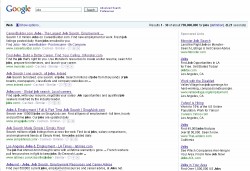 Drawing recruiting lessons from a study of conversion rates for e-retail shoppers may seem a peculiar thing to do, and it probably is. But don’t let that deter you from considering what Engine Ready found when it studied the effectiveness of the various ways buyers came to a site.
Drawing recruiting lessons from a study of conversion rates for e-retail shoppers may seem a peculiar thing to do, and it probably is. But don’t let that deter you from considering what Engine Ready found when it studied the effectiveness of the various ways buyers came to a site.
The just-completed study reaffirmed a finding first reported in January 2008 that visitors who arrive at a retailer’s site by clicking on a paid search ad were more likely to make a purchase than were those who got there by clicking on an organic search result. How much more likely? Sixty one percent more.
The highest conversion rate — 7.38 percent — came from those visitors who arrived at the site by typing in the address or using a bookmark. Those who arrived by clicking on a link in an email or another site, converted at a rate of 6.58 percent.
The Engine Ready study also found PPC (pay per click) search advertising — buying keywords that appear on search engine results pages — yields higher sales volumes than does a user clicking out of the organic (free) listings. In fact, buyers who found the site via PPC ads spent on average almost $8 more per purchase than those who came in by clicking a link from elsewhere, which was the next highest category.
I don’t want to overstate what these numbers might mean for recruiters, but there is a striking similarity between retailers seeking to attract quality (high spending) customers and employers searching for quality workers. Whether you buy that or not, the Engine Ready study is worth considering when debating where to put limited marketing dollars.
Microsoft, as Marvin Smith explained in Thursday’s ERE article “Sourcing Insights: SEO is Not Enough!”, is fully engaged in a program to elevate its job openings to the top of the first page on Google. That effort — Search Engine Optimization — has resulted, he reports, in 97 percent of his division’s jobs appearing on that first page. A success to be sure and one which has resulted in “a significant increase in traffic” to the jobs.
For recruiters without the means to provide a distinct landing page for each job as well as keyword-laden job descriptions, and to simultaneously finance a PPC campaign on the major search engines, the Engine Ready report offers some guidance about the most effective use of online recruitment marketing dollars.
With the vast majority of companies lacking an effective SEM strategy, according to Arbita’s Recruitment Genome Project, a strategy that at leasts tests the conclusions in the Engine Ready report is an improvement.
Look over the January 2008 report (the 2009 report has not yet been publicly posted). You’ll find that the current findings mirror those of 18 months ago. One curious finding of that earlier report is that the value of every visitor arriving from a referral source — this includes email — was higher than from any other source other than by direct access (typing in the address or using a bookmark).
Here, again, the parallels shouldn’t be taken too far, but the result does suggest that building a relationship with quality candidates can pay off.
Creating an online recruitment marketing strategy based on an e-retail study is not what I’m advocating. Instead, consider the implications of the report before deciding where to invest limited marketing dollars.